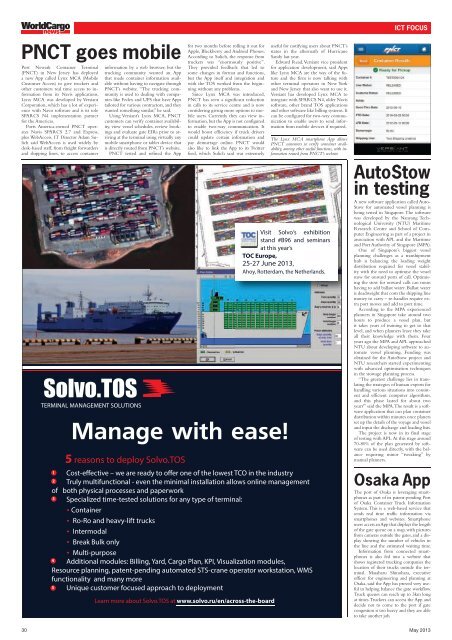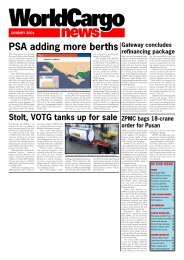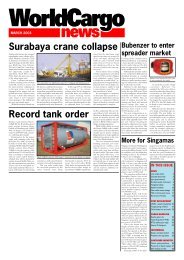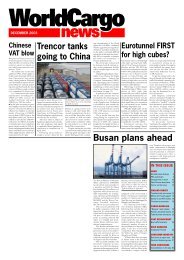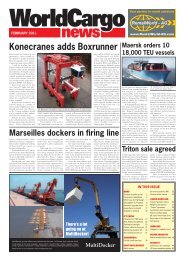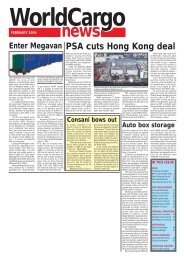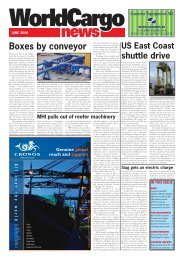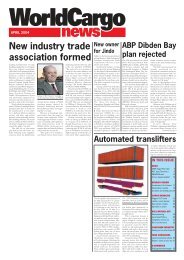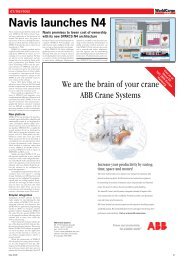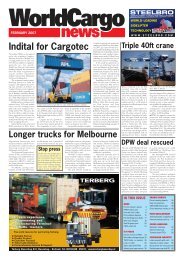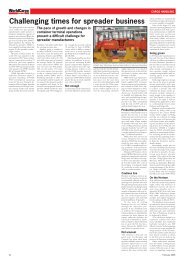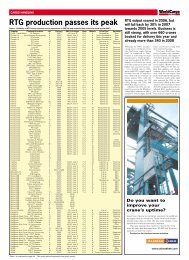Tanjung Priok super port - WorldCargo News Online
Tanjung Priok super port - WorldCargo News Online
Tanjung Priok super port - WorldCargo News Online
Create successful ePaper yourself
Turn your PDF publications into a flip-book with our unique Google optimized e-Paper software.
ICT FOCUS<br />
PNCT goes mobile<br />
Port Newark Container Terminal<br />
(PNCT) in New Jersey has deployed<br />
a new App called Lynx MCA (Mobile<br />
Customer Access) to give truckers and<br />
other customers real time access to information<br />
from its Navis applications.<br />
Lynx MCA was developed by Versiant<br />
Corporation, which has a lot of experience<br />
with Navis software and is its sole<br />
SPARCS N4 implementation partner<br />
for the Americas.<br />
Ports America-owned PNCT operates<br />
Navis SPARCS 2.7 and Express,<br />
plus WebAccess. IT Director Adam Sulich<br />
said WebAccess is used widely by<br />
desk-based staff, from freight forwarders<br />
and shipping lines, to access container<br />
Solvo.TOS<br />
TERMINAL MANAGEMENT SOLUTIONS<br />
information by a web browser, but the<br />
trucking community wanted an App<br />
that made container information available<br />
without having to navigate through<br />
PNCT’s website. “The trucking community<br />
is used to dealing with companies<br />
like Fedex and UPS that have Apps<br />
tailored for various contractors, and they<br />
wanted something similar,” he said.<br />
Using Versiant’s Lynx MCA, PNCT<br />
customers can verify container availability,<br />
view vessel schedules, review bookings<br />
and evaluate gate EIRs prior to arriving<br />
at the terminal using virtually any<br />
mobile smartphone or tablet device that<br />
is directly routed from PNCT’s website.<br />
PNCT tested and refined the App<br />
for two months before rolling it out for<br />
Apple, Blackberry and Android Phones.<br />
According to Sulich, the response from<br />
truckers was “enormously positive”.<br />
They provided feedback that led to<br />
some changes in format and functions,<br />
but the App itself and integration and<br />
with the TOS worked from the beginning<br />
without any problems.<br />
Since Lynx MCA was introduced,<br />
PNCT has seen a significant reduction<br />
in calls to its service centre and is now<br />
considering giving more options to mobile<br />
users. Currently they can view information,<br />
but the App is not configured<br />
to enable two-way communication. It<br />
would boost efficiency if truck drivers<br />
could update certain information and<br />
pay demurrage online. PNCT would<br />
also like to link the App to its Twitter<br />
feed, which Sulich said was extremely<br />
Manage with ease!<br />
5 reasons to deploy Solvo.TOS<br />
useful for notifying users about PNCT’s<br />
status in the aftermath of Hurricane<br />
Sandy last year.<br />
Edward Read, Versiant vice president<br />
for application development, said Apps<br />
like Lynx MCA are the way of the future<br />
and the firm is now talking with<br />
other terminal operators in New York<br />
and New Jersey that also want to use it.<br />
Versiant has developed Lynx MCA to<br />
integrate with SPARCS N4, older Navis<br />
software, other brand TOS applications<br />
and other software like billing systems. It<br />
can be configured for two-way communication<br />
to enable users to send information<br />
from mobile devices if required.<br />
The Lynx MCA smartphone App allows<br />
PNCT customers to verify container availability,<br />
among other useful functions, with information<br />
routed from PNCT’s website<br />
1 Cost-effective – we are ready to offer one of the lowest TCO in the industry<br />
2<br />
Truly multifunctional - even the minimal installation allows online management<br />
of both physical processes and paperwork<br />
3<br />
4<br />
Specialized time-tested solutions for any type of terminal:<br />
• Container<br />
• Ro-Ro and heavy-lift trucks<br />
• Intermodal<br />
• Break Bulk only<br />
• Multi-purpose<br />
Additional modules: Billing, Yard, Cargo Plan, KPI, Visualization modules,<br />
Resource planning, patent-pending automated STS-crane operator workstation, WMS<br />
functionality and many more<br />
5 Unique customer focused approach to deployment<br />
Learn more about Solvo.TOS at www.solvo.ru/en/across-the-board<br />
Visit Solvo‘s exhibition<br />
stand #B96 and seminars<br />
at this year’s<br />
TOC Europe,<br />
25-27 June 2013,<br />
Ahoy, Rotterdam, the Netherlands.<br />
AutoStow<br />
in testing<br />
A new software application called Auto-<br />
Stow for automated vessel planning is<br />
being tested in Singapore. The software<br />
was developed by the Nanyang Technological<br />
University (NTU) Maritime<br />
Research Centre and School of Computer<br />
Engineering as part of a project in<br />
association with APL and the Maritime<br />
and Port Authority of Singapore (MPA).<br />
One of Singapore’s biggest vessel<br />
planning challenges as a transhipment<br />
hub is balancing the loading weight<br />
distribution required for vessel stability<br />
with the need to optimise the vessel<br />
stow for onward <strong>port</strong>s of call. Optimising<br />
the stow for onward calls can mean<br />
having to add ballast water. Ballast water<br />
is deadweight that costs the shipping line<br />
money to carry – re-handles require extra<br />
<strong>port</strong> moves and add to <strong>port</strong> time.<br />
According to the MPA experienced<br />
planners in Singapore take around two<br />
hours to produce a vessel plan, but<br />
it takes years of training to get to that<br />
level, and when planners leave they take<br />
all their knowledge with them. Four<br />
years ago the MPA and APL approached<br />
NTU about developing software to automate<br />
vessel planning. Funding was<br />
obtained for the AutoStow project and<br />
NTU researchers started experimenting<br />
with advanced optimisation techniques<br />
in the stowage planning process.<br />
“The greatest challenge lies in translating<br />
the strategies of human experts for<br />
handling various situations into consistent<br />
and efficient computer algorithms,<br />
and this phase lasted for about two<br />
years'” said the MPA. The result is a software<br />
application that can plan container<br />
distribution within minutes once planers<br />
set up the details of the voyage and vessel<br />
and input the discharge and loading lists.<br />
The project is now in its final stage<br />
of testing with APL. At this stage around<br />
70-80% of the plan generated by software<br />
can be used directly, with the balance<br />
requiring minor “tweaking” by<br />
manual planners.<br />
Osaka App<br />
The <strong>port</strong> of Osaka is leveraging smartphones<br />
as part of its patent-pending Port<br />
of Osaka Container Truck Information<br />
System. This is a web-based service that<br />
sends real time traffic information via<br />
smartphones and websites. Smartphone<br />
users access an App that displays the length<br />
of the gate queue on a map, with pictures<br />
from cameras outside the gates, and a display<br />
showing the number of vehicles in<br />
the line and the estimated waiting time.<br />
Information from connected smartphones<br />
is also fed into a website that<br />
shows registered trucking companies the<br />
location of their trucks outside the terminal.<br />
Masaharu Shinohara, executive<br />
officer for engineering and planning at<br />
Osaka, said the App has proved very useful<br />
in helping balance the gate workflow.<br />
Truck queues can reach up to 3km long<br />
at times. Truckers can access the App and<br />
decide not to come to the <strong>port</strong> if gate<br />
congestion is too heavy and they are able<br />
to take another job.<br />
30<br />
May 2013


